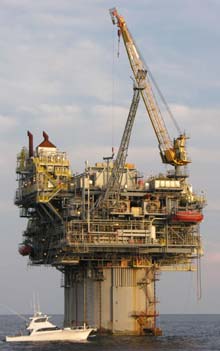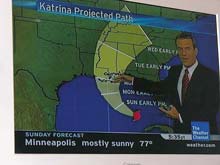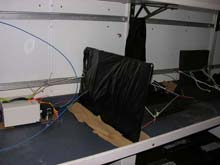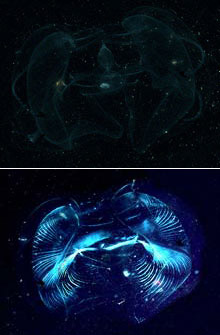
Oil rigs of various types ringing the Gulf have been a common sight for the past two days. Click image for larger view.
Escaping the Storm
August 27, 2005
Dan Speiser
Duke University
Latitude: 28° 41.305’ N
Longtitude: 91° 19.482’ W
Saturday arrived with the RV Seward Johnson afloat on the green-brown waters of a Port Fourchon, Louisiana boat canal. We had arrived at this outskirt of the Mississippi Delta the previous afternoon. Docking had proven necessary after the winch, used for deploying and retrieving the submersible, had malfunctioned and subsequently proven an unlikely fix at sea. Our plans were to wait in port until new parts arrived the next day. A rusting work platform was lowered several stories on its stilts to rest just over our ship’s stern and we settled in for the night amidst anchor handlers, supply ships, and other members of the vast support fleet for the oil rigs that loomed offshore.

Ship and science crew have been paying close attention to weather updates about Katrina's strengthening power and expected landfall. Click image for larger view.
We were, however, not to remain long in Port Fourchon. Hurricane Katrina had finished with Florida by late Friday and was now, come Saturday, slowly passing over the Gulf, gaining further power from the warm water below, and threatening a second land-fall at our exact location. By early morning we had received orders to leave port and at eight o’clock we were on our way to Texas. The new plan was for Edie Widder’s husband, Dave Smith, to fly to Galveston and to meet us in port with the replacement parts for the winch. We would then make repairs, wait out the worst of the storm, and head back east to retrieve the Eye-in-the-Sea, which we had been forced to leave on the ocean floor back at Vioska Knoll.
Saturday passed with us steadily westward bound, Katrina growing from a category 2 to a category 3 in our wake. Even without being able to make any submersible or SCUBA dives, there was still plenty of scientific work to complete. Data collected from previous days was analyzed, such as the underwater UV and polarized light measurements made by Sönke Johnsen and Justin Marshall, and the boat slowed long enough for Mike Matz and Jon Cohen to make plankton tows in the early afternoon and at sunset.

It may not be a highly technological tie-down system, but our equipment is all secured in anticipation of possible rough seas. Click image for larger view.
As a second-year graduate student, newly introduced to oceanography, I have had much to learn about the practical aspects of doing research at sea. For instance, the ocean comes with waves, particularly during hurricane season, and one’s instrumentation needs to be securely tied down. I had received warning about this before I came onboard, but it failed to fully take hold. Suffice to say, after a couple days of travel, some panic, some improvisation, and with a liberal application of nylon rope, cable ties, and electrical tape, I was able to cobble together a fairly seaworthy work station.

The lobate ctenophore Ocyropsis maculata as viewed under unpolarized light (top) and polarized light (bottom). Click image for larger view and image credit.
On last Thursday’s blue water dive we came into a dense layer of lobate ctenophores at about 15-20 feet from the surface. These were just the sort of animal I was looking for and Sönke and I were able to get a good number into our collecting jars. I was now all set to begin my work in earnest. My research plan for the trip has been to look for light-responsiveness in eyeless, pelagic animals. The ctenophores we collected were a good fit for such a study because they are common in near-surface waters and because they are active enough swimmers to perform behavioral experiments upon. My hypothesis has been that eyeless, but light-responsive animals may orient to their ocean environment by taking advantage of how different wavelengths of light pass through water. For instance, if an animal were to gravitate toward the deep-penetrating short wavelengths (blues and greens) and move away from the shallow-penetrating long wavelengths (oranges and reds), it would have the potential to select between different light environments.
Eyeless animals may seem an unlikely place to look for visually mediated behavior. However, recent findings of genes related to vision in jellyfish and Justin Marshall’s discovery of light-responsiveness in sponge larvae suggest that interesting information about the origin and evolution of vision may be gathered from even the most primitive of animals. While I have yet to perform enough tests for a strong pattern to emerge from the data, I remain optimistic about the appearance of more animals and the possibility that something new, interesting, or just plain unexpected will come out of my efforts. So, with a day or two of repairs and the hopefully brief and merciful passing of Katrina, we will be back on our way, exploring the Gulf from its surface to its furthest depths.


























